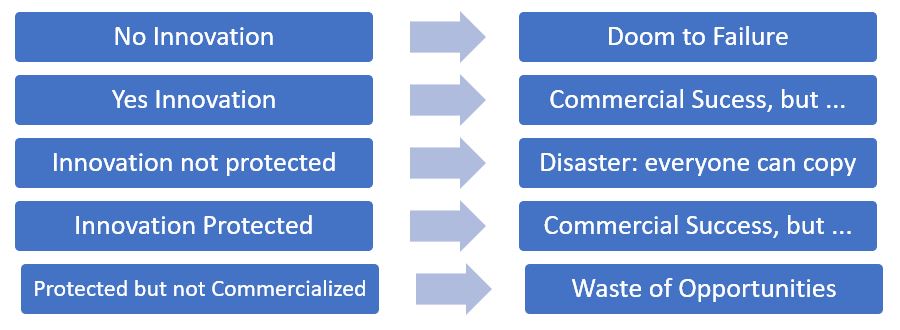How IPRs can support SMEs Business
Now let’s see the main advantages of IP, particularly for SMEs in the ASEAN region:
- First and foremost, as mentioned above, IP allows you to protect the outcome of your creativity and innovation. This means that, subject to some exceptions:
- Nobody can copy what you have created,
- Nobody can use it without your authorization,
- You can set the conditions at which your goods will be sold and your services provided (and often this implies a premium price), and
- Remember: you have exclusive rights! And this will give you, on the one hand, a stronger position on the market, and on the other, an excellent return on investment.
- Once protected, your IP rights can be licensed-out as many times as you wish, to numerous potential licensees (producers, distributors, agents, etc.) in various countries. This means that you can focus on your domestic market and relax at home, while your IPRs are operationalized in many countries and … at the end of the month you will receive the corresponding royalties (see Handbook on IP Commercialisation, Section C.2 on Licensing).
- Conversely, if you don’t have the necessary funds to undertake R&D to develop your own innovation and protect it under the relevant IPRs, then you still have a solution to innovate: identify the relevant innovative products or technologies which have been successfully developed by third parties in other countries, and obtain a license (is: license-in), under certain conditions (e.g. payment of royalties, etc.).
- Owning protected IPRs (whether developed by your company or acquired through a license) will allow your company to be a more credible and powerful partner in possible and profitable cooperation and contractual agreements. Through your IPRs, you will be able to attract investors and business partners from universities or research institutes to larger companies or other SMEs. Collaboration is important for SMEs in order to fill gaps in their own resources and expertise, and to overcome their challenges in a strategic and resource-effective way, in areas such as:
- Product development;
- Improvement of innovative processes in all phases of the business cycle;
- Hastening of the commercialisation of new solutions;
- Reduction of the time to innovate;
- Increasing the scope of innovation; etc.
- In all these collaboration agreements and licenses (in and out), thanks to your IPRs, your company will have a stronger position and enjoy more bargaining power.
- Owning IPRs will make an SME more attractive to investors and more trustworthy to financial institutions. This is because IPRs have monetary value and can be used as collateral to guarantee loans. In other words, IP will enhance the company’s capacity to access capital and raise funds (see Handbook on IP Commercialisation, Section A.4 on on raising capitals using IPRs).
- It is common knowledge that nowadays the value of a company is linked much more to its intangible assets (i.e. IPRs, whether registered or not), than to its tangible possessions and resources. By way of example, in 2019 the value of brands such as Amazon® and Apple® was estimated at USD 187.9 billion and USD 153.6 billion, respectively (see Handbook on IP Commercialisation, Section A.3 on IP Valuation).
- IP will also significantly help you in handling litigations, enhancing your chances of success, and reducing litigation risks (see Handbook on IP Commercialisation, Section IV of the on Enforcement).

However, unfortunately, many SMEs still struggle to take full advantage of IP. For many SMEs, it may be simply a question of ignorance of this relatively new topic that, at first, might seem of secondary importance and definitely less … tangible! Other challenges for SMEs include:
- The costs for IP protection: registering your IPRs in many countries around the world can be a costly affair. However, it is an investment that it is well worth undertaking, as the return can be extremely valuable. Perhaps, if needed, consider partnering with other companies, institutions, SMEs, etc. to share the registration costs. Remember also that interesting discounted rates are applicable to applicants from Least Developed Countries.
- Widespread violation of IPRs (counterfeit and piracy) may discourage SMEs from obtaining protection, in view of the high potential of being unlawfully copied and considering the weaknesses of the domestic enforcement systems. However, the situation is getting better and better every day (see Handbook on IP Commercialisation, Section IV of the on Enforcement).
- Insufficient expertise in this legal field (both in terms of acquisition of IPRs and their management and Commercialisation). IP is not “rocket science”, but is quite unique, technical and complex in some aspects. In this context, we would advise you to:
- Carefully read the contents of this website section “IP for Business”, the “Handbook to IP Commercialisation”, and the “Business Guide to IP Institutions, Laws and Filing Processes in AANZFTA Parties”, available at AANZFTA website (https://aanzfta.asean.org/).
- Contact one of the institutions that provide free advice on IP, such as your national IP office, a chamber of commerce, IP and Innovation help desks; and Consult a specialist in your country (for these last two items, please refer to Chapter 3 of the Business Guide above).
Next page: Commercialisation of IPR - Introduction
Go to the Table of Contents



